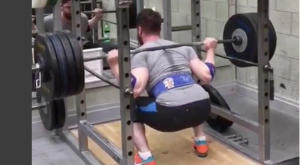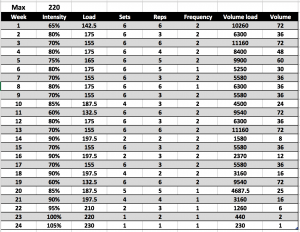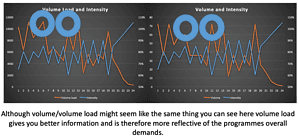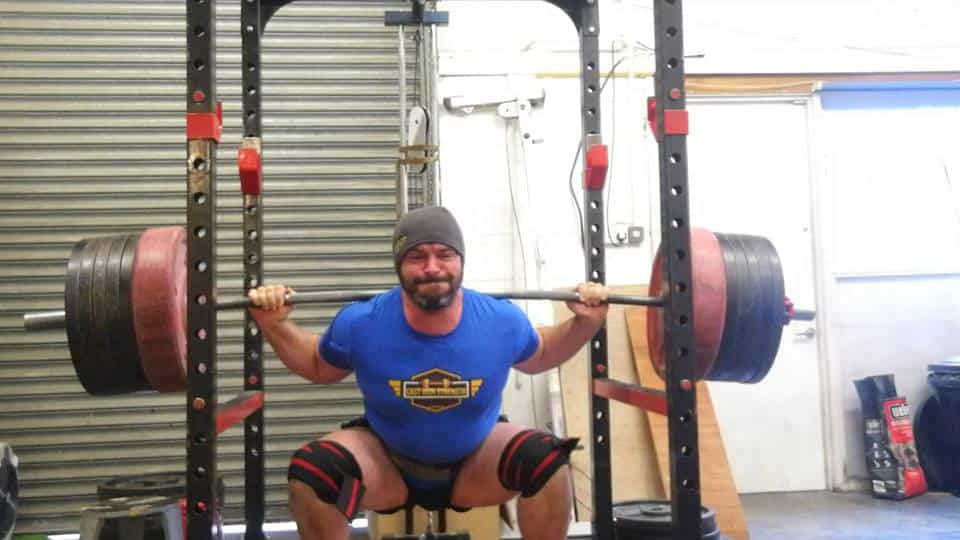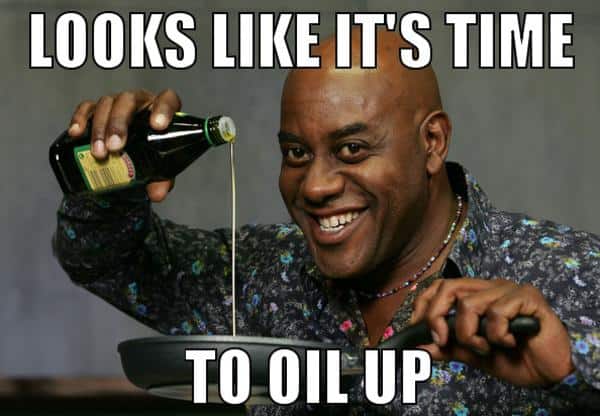When it comes to programming there are a whole bunch of variables to consider some of which can lead to massive gains in a very short period of time when it comes down to things such as your technique or your exercises selection. However, the big hitters in the programming world are volume and intensity pretty much everyone gets stronger for the longest amount of time by manipulating these two variables.
Understanding volume and intensity and how they interact.
I’m not going to go into a 12 chapter book into what training intensity, training volume and volume load are in terms of planning training but we need to cover this off before we can pursue a more meaningful discussion on how to manipulate them.
Intensity – Intensity is the % of your maximal capacity for the lift, this is measured in simple terms by your one repetition maximum (most you can lift for 1 rep in that lift). There are other relative measures such as RPE or other objective measures such as bar speed but they all pretty much end up meaning the same thing in the long run. If your 1 rep max is 200kg and you lift 140kg your set is at 70% of 1RM and that is the measure of intensity that matters. You can look at session intensity by using relative intensity (average % of all sets of an exercise, session, week or month) or you can use INOL (intensity by the number of lifts) which can provide a measure of exercise, session or week intensities.
Volume – Volume is simply the total number of lifts you perform for a certain exercise or as a gross measure of all lifts done through a session, week or block of training.
Volume load – volume load is a way of quantifying training intensity and volume into a more representative measure of fatigue. It is very simple volume load is intensity (or weight lifted) x volume (number of reps completed).
There you have it in it’s very limited but most effective definition volume, intensity and volume load.
Creating overload and allowing for recovery using volume and intensity.
Now that you should be on board with what these terms refer to when we talk about strength training the next piece of the puzzle is to understand the stress they put on the body and thus the adaptation they provide.
Intensity – is more related to the skill of lifting heavy things. In simple terms practising lifting heavy weights makes you more efficient and skilled at lifting heavy weights. The co-ordination, timing and local muscular tension required to perform a good 98% single is different from performing the same task with a 20-30% load. When the weight increases the margin for error reduces dramatically.
A lot of the adaptation from the intensity of effort come from a mixture of neural factors (motor unit recruitment, inter/intramuscular coordination, switching off of inhibitory mechanisms i.e. Golgi tendons and the like, amongst other factors). This is an overly simplified way of looking at this however it is intended as so since it’s not important for the outcome.
Volume – The more practice you can do and recover from it the better your going to become. The more intense the practice is, however, the less you can do and the more likely you are going to burn out. A lot of the benefits of volume come from the ability to perform more of the task and work on general co-ordination or bringing certain concepts or skills learning from conscious thought into the realm of subconscious action.
A lot of the benefits of volume of effort are to be had from what can be termed as mechanical factors such as muscle size, bone density and other improvements to connective tissue and overall body conditioning. Again this is a gross oversimplification but is sufficient an understanding that you can utilise it in your programming.
Volume Load – volume load is a good overall marker of how stressful a training session or week is since it takes into account the two biggest independent factors. Any programme that just ramps up volume load of training will eventually lead to overreaching and eventually overtrain which can be desirable when applied at the correct time.
 First things first separate the two variables.
First things first separate the two variables.
In general terms or in blocks where the goal is progressive overload without leading to an overreach or a lack of fatigue management separating volume and intensity into siloed sessions, weeks or months can be a good idea. A lot of periodization gets its main idea from this core idea.
Linear/Classical – tends to start with high volume and low intensity and over time crossfades from a focus of one to another.
Block – tends to put an emphasis of one variable while downplaying the other to try and create phase potentiation or flow from one training block to the next. An easy example of this is the use of volume to better work on the lifters overall conditioning and work capacity followed by a block of overload using a mixture of higher intensity lifts at volumes that produce and overload stress. The use of high volume in the first block leads to the ability to better perform high workloads and to recover from them.
Daily undulating periodization – DUP usually splits workouts into focuses one where the focus on higher intensities, one where the focus is on higher volumes and one which is either a mixture of the two or one that acts as a lighter or recovery workout.
What we can learn from these three “periodisation” examples is that there is something to separating the two training variables that lead to a better recovery profile or else people wouldn’t organise their training like this.
What if we just indefinitely flip-flopped between volume and intensity?
One of the cornerstones of my average training block is the change of focus from week to week. I appropriated this idea (stole) from the Boris Sheko seminar from 2016. Boris basically produces a random overload scheme in his blocks and he uses volume as his main marker of load or number of lifts. Although I could see the general aim of what he was doing I am nowhere near experienced or intelligent enough to directly steal his method. So I stole the idea of week focus.
What I do now change the focus of training from week to week to either be a volume focus or an intensity focus. In general, these can be defined as thus.
Volume focus week – 250-500 total lifts (spread over the three powerlifts and their variations), Relative intensity of 55-70% and the focus is really on the quality and intensity of execution. Look to have lifters displaying as close to perfect technique as they can muster and to really focus on the concentric speed of the concentric effort.
Intensity focus week – 90-200 total lifts (spread over the three powerlifts and their variations), relative intensity of 70-85% and the focus is to try and maintain the technical execution of the lift under more duress and load. I am willing to accept some breakdown in execution and bar speed to allow the lifter to get an overload or stress response from the training.
When we flip flop from one to the other it then becomes about how do we ensure the lifter is making progress and not just going round in circles in some kind of endless technique focused round about. You need to keep your eyes on the main measure of progress for the training or stress – volume load.
For volume load, I like to think of it in terms of accumulation of meaningful volume. Meaningful volume is defined by me as a volume of exercise done with intention and deliberate execution will lead to an increase in top end capacity or performance. Non-meaningful volume is exercises, assistance work or intensities/sets that don’t have a direct carry over to the goal at hand. For a powerlifter, DB shoulder press will always be non-meaningful volume because it does not convey a direct performance benefit to the bench press. I find this lynch pin to be of incredible use when programming for any goal or person since it immediately prioritises what is going to achieve your bottom line results.
Now we can split meaningful volume into our two subcategories of volume based focus and intensity based focus with the understanding that they are working on two general aspects of maximal lifting as a skill and also conveying other beneficial training outcomes.
Now hopefully you are clear on the classification of Volume and Intensity as variables in training and how they work/interact to produce overload. Now we must discuss how to utilise meaningful volume as the underlying factor to ensure
- We are making progress.
- We are not unintentionally inducing an overreach
- We are allowing for low weeks in the training for recuperation.
Tracking Meaningful Volume.
We will now go through an example of a 24 weeks training block for someone with a maximum of 220kg, we would expect a better outcome than 105% but the peak at the end is more for demonstration purposes.
In general terms, we have 3 phases of training here. There is an accumulation phase from weeks 1-8 working at 80% where we are ensuring that the volume load per week is going up in this zone week to week, to the point where we are expecting you will need to back off. Then you have a recuperation week. Followed by a transition into the next accumulation phase week 14-16 working at 90% of RM following the same line of thought, followed by a recuperation week and then a peak.
The start of the training cycle in gross terms is much higher in volume load and lower in intensity and at the peak of the block intensity peaks and volume drops away. What we will go through now is why tracking the volume load or “meaningful volume” is more representative of what is actually going on than tracking the volume alone.
If we put the two together on the same graph and different axis you can see they match up pretty evenly what if we take volume and volume load and plot them both against intensity?
If we look at the volume on its own or even against intensity it becomes difficult if not impossible to get a true representation of what is happening in the bigger picture.
This is again an overly simplistic way of looking at it but I want you to grasp the key concepts
- Volume and Intensity have generally speaking different effects on the body.
- Contrasting them against each other allows for longer periods or progress and overload.
- Accumulation of meaningful volume is the real money maker when it comes to getting stronger.
- Always keep your mind on the bottom line – Accumulation of meaningful volume.
- Don’t plan for overly elongated periods of this training as it will lead to overreaching and overtraining.
- Deliberate practice during periods of lower intensity and higher volume can really give this training carry over and a focus.
- Periods of very low intensity and higher volumes are good ways of building in recovery into your training without detraining or losing a week.
- Finally, you need to have detraining built into your programme not randomly thrown in. Plan weeks off during the year to allow your body to catch up to the constant overload.
Marc



